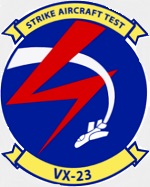Air Force 1 AF10010B US Navy Lockheed-Martin F-35C Lightning II Joint Strike Fighter - VX-23 "Salty Dogs", NAS Patuxent River, MD [Low-Vis Scheme] (1:72 Scale)
"The F-35 program executive officer, has stated that the 'F-35 enjoys a significant Combat Loss Exchange Ratio advantage over the current and future air-to-air threats, to include Sukhois, which are currently being flown by the Russian, Indian, and Chinese Air Forces.'"
- Maj Gen Charles R. Davis, USAF, the F-35 program executive officer
 The F-35C combines the unique capability of operating from a carrier deck with the unmatched 5th Generation capabilities of stealth, fused sensors and reliability, making the F-35C the Navy's future first-day-of-the-war strike fighter.
The F-35C combines the unique capability of operating from a carrier deck with the unmatched 5th Generation capabilities of stealth, fused sensors and reliability, making the F-35C the Navy's future first-day-of-the-war strike fighter.
The Navy and Marines require an aircraft capable of overcoming a variety of threats - surface-to-air missiles, air-to-air missiles and tactical aircraft. By leveraging this potent combination of stealth, advanced jamming and threat system destruction, the F-35C enhances survivability and increases mission success rates.
The F-35C variant has larger wings and more robust landing gear than the other variants, making it suitable for catapult launches and fly-in arrestments aboard naval aircraft carriers. Its wingtips also fold to allow for more room on the carrier's deck while deployed.
The F-35C also has the greatest internal fuel capacity of the three F-35 variants. The F-35C carries nearly 20,000 pounds of internal fuel for longer range and better persistence than any other fighter in a combat configuration. And, like the F-35B, the F-35C uses probe and drogue refueling. This allows the Navy to operate its carriers a safe distance from the threat while its fighters reach remote targets.
Pictured here is a 1:72 scale replica of a US Navy Lockheed-Martin F-35C Lightning II Joint Strike Fighter that was attached to VX-23 "Salty Dogs", then deployed to NAS Patuxent River, MD.
Now in stock!
Dimensions:
Wingspan: 7-1/4-inches
Length: 8-1/2-inches
Release Date: October 2021
 Historical Account: "The Salty Dogs" - VX-23 Air Test and Evaluation Squadron 23 (AIRTEVRON TWO THREE, nickname The Salty Dogs) is a United States Navy air test and evaluation squadron based at Naval Air Station Patuxent River, Maryland. Using the tail code SD, the squadron operates multiple aircraft types of the United States Navy.
Historical Account: "The Salty Dogs" - VX-23 Air Test and Evaluation Squadron 23 (AIRTEVRON TWO THREE, nickname The Salty Dogs) is a United States Navy air test and evaluation squadron based at Naval Air Station Patuxent River, Maryland. Using the tail code SD, the squadron operates multiple aircraft types of the United States Navy.
VX-23 is an Aircraft Test Squadron that conducts research, testing and evaluation of fixed wing tactical aircraft and UAV's. VX-23 provides aircraft, pilots, maintenance services, safety oversights and facility support for these operations. Their main mission is flying qualities and performance evaluations, shipboard suitability, propulsion system testing, tactical aircraft mission systems testing, ordnance compatibility and ballistics efforts, reliability and maintainability assessments, flight fidelity simulation and flight control software development. The squadron also provides Government Flight Representative, test monitoring, chase aircraft support, facilities for contractor demonstration, validation and development work involving tactical aircraft and associated systems.
General characteristics Crew: 1 - Length: 51.4 ft (15.67 m)
- Wingspan: 35 ft (10.7 m)
- Height: 14.2 ft (4.33 m)
- Wing area: 460 ft (42.7 m)
- Empty weight: 29,300 lb (13,300 kg)
- Loaded weight: 44,400 lb (20,100 kg)
- Max takeoff weight: 70,000 lb (31,800 kg)
- Powerplant: 1 Pratt & Whitney F135 afterburning turbofan
- Dry thrust: 28,000 lbf (125 kN)
- Thrust with afterburner: 43,000 lbf[256] (191 kN)
- Internal fuel: 18,480 lb (8,382 kg)
- Performance
Maximum speed: Mach 1.67 (1,283 mph, 2,065 km/h) - Range: 1,200 nmi (2,220 km) on internal fuel
- Combat radius: 610 nmi (1,110 km) on internal fuel
- Service ceiling: 60,000 ft (18,288 m)
- Rate of climb: classified (not publicly available)
- Wing loading: 91.4 lb/ft² (446 kg/m)
- Thrust/weight:
With full fuel: 0.84; - With 50% fuel: 1.04 B:
- g-Limits: 9 g
- Armament
Guns: 1 GAU-22/A 25 mm (0.984 in) cannon internally with 180 rounds - Hardpoints: 6 external pylons on wings with a capacity of 15,000 lb (6,800 kg) and 2 × internal bays with 2 pylons each[60] for a total weapons payload of 18,000 lb (8,100 kg) and provisions to carry combinations of:
- Missiles:
Air-to-air: AIM-120 AMRAAM, AIM-132 ASRAAM, AIM-9X Sidewinder, IRIS-T - Air-to-ground: AGM-154 JSOW, AGM-158 JASSM
- Bombs:
Mark 84, Mark 83 and Mark 82 GP bombs - Mk.20 Rockeye II cluster bomb
- Wind Corrected Munitions Dispenser capable
- Paveway-series laser-guided bombs
- Small Diameter Bomb (SDB)
- JDAM-series
- B61 nuclear bomb (in 2017)
- Avionics
Northrop Grumman Electronic Systems AN/APG-81 AESA radar - Differences across variants
- ^ B is the same, C: 14.9 ft (4.54 m)
- ^ C is same, B: 60,000 lb (27,000 kg)
- ^ F-35B: 14,003 lb (6,352 kg); F-35C: 20,085 lb (9,110 kg)
- ^ F-35B: 7.5 g, F-35C: 7.5 g
- ^ fitted as an external pod with 220 rounds in the F-35B and F-35C
Wingspan: 7-1/4-inches
Length: 8-1/2-inches
|


